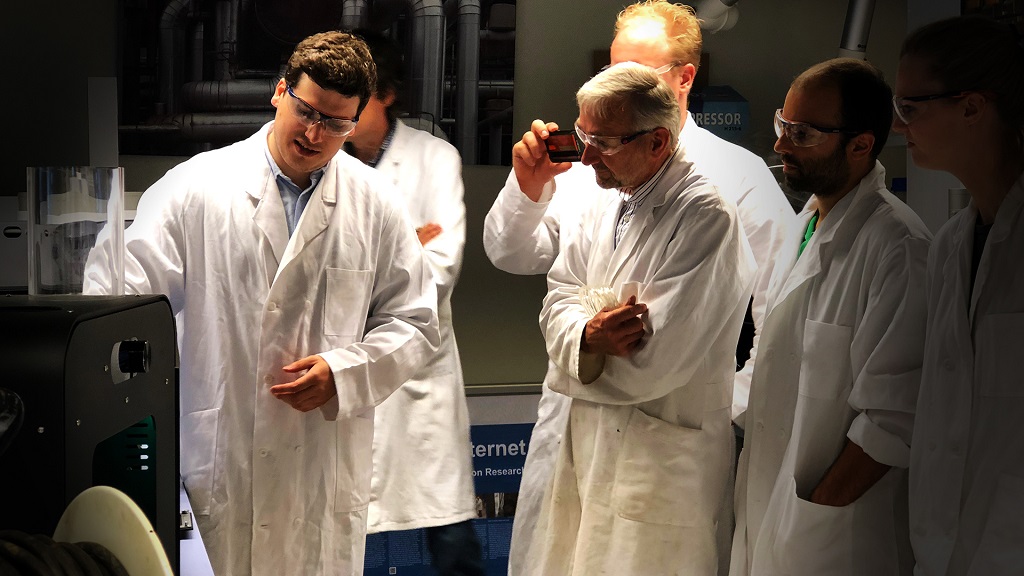![[Image: 3devo]](https://fabbaloo.com/wp-content/uploads/2020/05/Devo-Training_img_5eb09d4c78486.jpg)
So you’ve decided to make your own 3D printing filament. Great. …How?
There are plenty of reasons you might be inclined to make your own materials to 3D print with: you need certain mechanical properties, a particular color, a small batch, or something to experiment with that isn’t commercially available. There are even a few options on the market for extruders to turn thermoplastic pellets and/or recycled plastics into filament. But they’re not all good options, and even those that can perform well can lack in user friendliness.
There’s a lot to consider in materials. 3D printing has needs unique from other plastics processing, and the creation of filament requires precision and control, as well as materials understanding. Particularly when it comes to desktop extruders, there are also some issues in DIY filament. Netherlands-based 3devo has seemingly overcome many of these issues with their advanced solutions, though, and they’re eager to share what they’ve learned.
3devo offers both filament extruders and a materials recycler. The materials creation system has proven useful in lab and research environments in particular. But, like most processes involved in 3D printing, that doesn’t mean it’s necessarily as simple as we might like to think. Just like a 3D printer isn’t as user-friendly as a microwave or just-press-print paper printer (as years-old consumer hype would have liked us to think), a filament maker isn’t quite so easy as tossing in some plastic and awaiting perfection.
That’s why the 3devo team is announcing a new initiative set to launch next week.
“A deeper understanding in polymer extrusion with the Filament Maker really takes away ‘the coffee machine’ idea, where you throw in material and expect a great outcome. It is very interesting to know that there are many influencing factors in this process, and how you can take those matters into your own hands to produce stable filament,” Timo van der Laak, 3devo Extrusion Expert/ Material Specialist, tells Fabbaloo.
A new hands-on program, DevoTraining, is set to bring extrusion and materials knowledge to individuals and teams hoping to learn how to get professional results.
Knowledge and skills gaps remain a major barrier to adoption throughout the additive manufacturing industry, and that’s no different for the creation of the materials themselves. As more users gear up to potentially adopt new technologies, it’s critical that they have the resources available to train up.
3devo’s new training workshops have been developed in response to demand, and are geared toward educators, innovators, manufacturers, and researchers at any level of existing expertise. Three programs will be available: a four-hour novice module, a one-day intermediate training, and a two-day master course. Helpful particularly for those in Europe, the hands-on workshops take place at 3devo’s Utrecht HQ.
The workshops cover core concepts of filament extrusion all the way up to advanced theories in materials development, material mixing, recycling, and customizable modules.
“Getting an output is a good start, but achieving great quality is where the challenge lies. DevoTraining combines theoretical knowledge about polymers and practical extrusion experience, resulting in the winning combination for successful extrusion,” Louis Rinaldo, 3devo Extrusion Expert/ Material Specialist, tells Fabbaloo.
It’s one thing to have equipment; it’s another to use it appropriately and to its full potential. Engineers, filament extrusion specialists, and materials scientists will lead the workshops, putting to use the equipment and materials at 3devo HQ.
“The DevoTraining offers a steep learning curve throughout, on applications, theory and functionalities,” Tim Wesselink, CEO of 3devo, tells Fabbaloo. “Resulting in an increased overall equipment effectiveness with our customers.”
The courses will be available starting February 12th; these include DevoNovice (€499), DevoProficient (€899), and DevoMaster (€1549).
As 3D printing continues to advance, we’re sure to see more training opportunities continue to arise across the board — and that’s a very good thing, indeed. From materials to 3D printing to post-processing, additive manufacturing encompasses an involved and not-necessarily-intuitive series of processes.
It’s particularly important that 3devo’s new workshops include both theoretical and hands-on learning. One without the other can lead to errors that could otherwise have been avoided. Understanding how certain polymers interact, the differences between virgin and recycled materials’ properties, and grasping the end-to-end process of just what goes on in an extruding machine will help participants reach the results they need for the work they do.
Via 3devo











CoreXY is becoming a very popular approach for 3D printer motion systems, but is it the ultimate answer? We list the advantages and disadvantages.